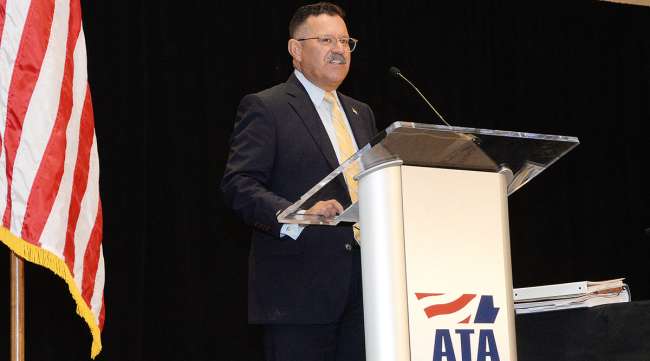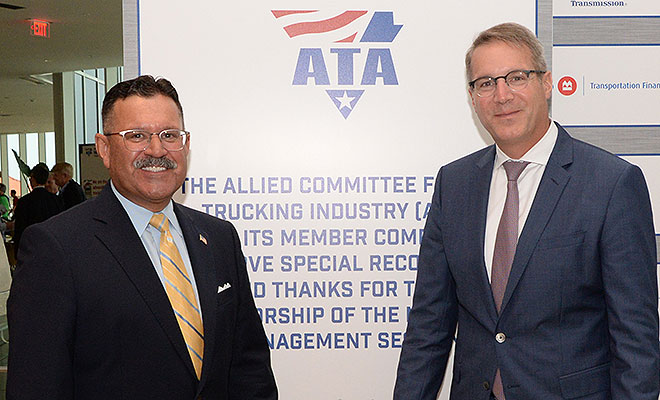Senior Reporter
FMCSA’s Ray Martinez Seeks Dialogue With Fleets, Drivers

MARCO ISLAND, Fla. — The head of the Federal Motor Carrier Safety Administration spotlighted key trucking issues — including hours-of-service rules, electronic logging devices and truck parking — during remarks here at an industry meeting, and stressed that he wants his agency to build a positive relationship with fleets and drivers.
“I remind my staff that safety is our priority, but we don’t have a monopoly on safety,” FMCSA Administrator Ray Martinez said. “We don’t have to rely [solely] on mandates, enforcement or punitive measures. We should also be just as focused on education, training, communication and cooperation.”
Martinez spoke at American Trucking Associations’ Mid-Year Management Session here May 20-23, addressing his comments to ATA’s Safety Policy Committee — the group’s largest committee.
Martinez’s previous regulatory history at the state level shows “an openness and willingness to work with our industry,” said ATA President Chris Spear, who introduced Martinez. “He cares deeply about our industry, and our drivers, even more importantly. We are happy to have him in Washington.”

Martinez (left), Spear by Jaclyn O'Laughlin
Martinez, who previously served as chairman of the New Jersey Motor Vehicle Administration, now leads an agency with 50 state offices and 1,100 personnel.
Looking broadly at safety issues facing trucking, he stressed that additional truck parking should be included in any infrastructure bill, and said that FMCSA plans a listening session this year on changes that are needed for data collection related to crashes.
He also had positive words for the industry’s transition to electronic logging devices, use of which was mandated for most drivers on Dec. 18.
“It’s working,” he said of the requirement, which shifts tracking of hours of service to the devices from paper logs. “We are impressed with the preliminary numbers.”
Martinez said there were 300,000 driver inspections during the soft-enforcement period for ELD usage that ended April 1, and less than 1% of drivers required to have ELDs were cited for violations.
On this point he offered praise for the industry, saying that some companies, owners and drivers, have a culture of day-to-day safety practices that meet or exceed any government mandates because it makes good business sense.
That said, he called HOS the elephant in the room and said there needs to be an honest conversation about what “tweaks” need to be made.
“Some sectors do have some unique needs,” he added. “To anybody who has trouble adopting this, we want to be helpful.”
But Congress could act, too, he said, and noted that waivers and exemptions that his agency have given to certain sectors of the trucking industry can complicate enforcement efforts. Martinez also suggested that at some point there might even be ELDs tailored to specific sectors of the industry, and noted that there currently are 370 different self-certified ELDs from 247 manufacturers.
Turning to data collection on crashes, Martinez said that FMCSA’s crash-preventability demonstration program, begun last summer, has generated 3,900 requests for data reviews.
The program allows carriers and drivers to have certain crashes treated as specialty crashes if the driver clearly could not have prevented the crash.
If found to be not-preventable crashes, companies will be given an alternative Safety Management System score as if the not-preventable crash was not included — although the review of the crash and the determination will be noted.
“I think this [full transparency] is a good first step,” he said.
In a related development, he said FMCSA would hold a listening session this summer related to the data-gathering recommendations for determining ratings under the Compliance, Safety and Accountability program.
“I think the industry probably knows more about what is relevant than we do,” he said. “What data do we really need?”
Driver detention and a shortage of truck parking spaces are other concerns he shares with the trucking industry, although his oversight is limited to related safety violations.
Driver detention needs to be addressed in light of the driver shortage, he said. “It seems to me that there is a major inefficiency in the supply chain if people are really [kept] waiting six hours [at a location].”
FMCSA has received 950 coercion complaints from fleets related to detention. It has launched a dozen enforcement actions — “but that is because we are really not getting the level of information that we need. That can be reported through our website,” he said.
Also, Martinez suggested that eventual legislation aimed at infrastructure repair and expansion should include language for additional truck-parking spaces.
“Appropriate locations that are safe for trucks to pull over at is something that needs to be addressed. I would hope that we could work with states to look at that,” he said.
Meanwhile, he reminded the industry executives at the well-attended session that commercial vehicle crashes, injuries and fatalities are on the rise. They can be expected to go even higher as the economy continues to strengthen and more miles are driven — if past is prologue.
“Our agency will be judged [by Congress] and asked, ‘Why didn’t you regulate more?’ That’s what really drives all this. It doesn’t have to be.”
At the conclusion of his nearly hourlong remarks, attendees gave Martinez a standing ovation.




